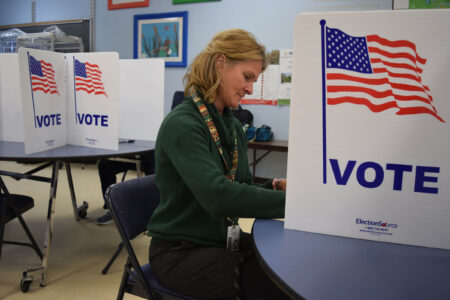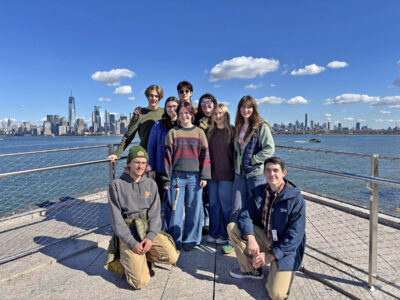DEC reminds New Yorkers to hunt safely this season
ALBANY — The state Department of Environmental Conservation reminds New Yorkers to hunt safely this season and encouraged all outdoor enthusiasts to respectfully share the woods and follow safety precautions.
Regular deer hunting season in the Northern Zone began Oct. 25 and closes Dec. 7. Bowhunting season for deer and bear is ongoing in the Southern Zone and ends on Nov. 14. The regular big game season in the Southern Zone begins Nov. 15.
“With nearly 600,000 New Yorkers participating annually, hunting is among the most popular forms of wildlife-related recreation in the state,” DEC Commissioner Amanda Lefton said. “Hunting remains a safe, ecologically important wildlife population management tool and fosters an understanding and respect for the environment. I encourage everyone enjoying the woods to be aware of their surroundings and follow all outlined safety measures while afield.”
The DEC notes that hunting is very safe and is getting safer thanks to the efforts of DEC’s Hunter Education Program, volunteer instructors and the vigilance of New York’s hunting community. More information on the Hunter Education program is available at tinyurl.com/4a44d2xt.
Due to ongoing efforts to teach hunting safety, responsibility and ethics, incident rates over the last five years are at the lowest levels recorded in New York, according to the DEC. Many, if not all, hunting-related incidents can be prevented by following the primary rules of hunter safety. These include:
¯ Treat every firearm as if it were loaded.
¯ Control the muzzle, always keep it pointed in a safe direction.
¯ Identify your target and what lies beyond it.
¯ Keep your finger off the trigger until ready to fire.
¯ Wear hunter orange or pink.
The DEC has additional tips for all hunters venturing afield this fall. These include:
¯ Tell someone your hunting location and anticipated return time. If plans change, notify them.
¯ Dress for the weather and plan for both location and elevation changes.
¯ Become familiar with planned hunting areas in advance.
¯ Pack the 10 essentials, especially a light source, knife, map and first aid kit. A full list is available at tinyurl.com/4a9sydmh.
Additionally, the DEC encourages all hunters in the state to “strap up before you go up” to improve tree stand safety. Like shooting incidents, elevated stand incidents can easily be avoided by following simple safety measures.
Hunters can protect against falls from a tree stand or elevated platform by using a fall-arrest system, which keeps a hunter attached to the tree from the time they leave the ground until they get back down. A harness alone is not sufficient if it isn’t attached to the tree the entire time the hunter is off the ground.
An effective Fall Arrest System includes:
¯ A full-body harness with shoulder, chest, and leg straps.
¯ A strap that attaches to the tree when in the stand.
¯ A tether strap that attaches the harness to the tree strap.
¯ A “lifeline” to keep a hunter safe while climbing and descending.
¯ A suspension relief strap to be used in the event of a fall.
Other important safety tips for hunting from an elevated platform include:
¯ Select a healthy, straight tree.
¯ Always maintain three points of contact (one hand and two feet or two hands and one foot) when climbing up or down from the stand.
¯ Inspect all equipment before using it. Replace stands, parts, harness, straps, and lifeline as necessary.
¯ Harnesses have an expiration date. Replace a harness if it is expired.
¯ Once secured in your stand, use a haul line to raise and lower your UNLOADED gun, bow, and cocked but unloaded crossbow, pointed down, into the stand. Do not tie the haul line around the trigger or trigger guard.
–
Remember to share the woods
–
Hikers should be aware that they may encounter hunters bearing firearms or archery equipment on trails. Hunters should likewise recognize that they may encounter hikers and others enjoying the outdoors. Hunting-related shooting incidents involving non-hunters are extremely rare, and hunting seasons in the past few years were among the safest ever, according to the DEC. A report on 2024 hunting safety statistics from the DEC is available at tinyurl.com/4dunyrmw.
Hunters can minimize the potential for disturbance by and to other forms of recreation by following a few tips. When hunters are scouting for the perfect spot or stand location, take the time to check if the planned location is popular. Avoiding locations that crowd other hunters or are near a sought-after hiking spot can improve both the hunting and recreational experience. If a preferred hunting spot is too crowded, identify an alternative location ahead of time.
The DEC maintains hiking, biking, skiing and snowmobile trails in many areas of state forest preserve lands in the Adirondacks, as well as in state forests, wildlife management areas and unique areas open to hunting.
–
Venison donations amidst potential SNAP cuts
–
With nearly 3 million New Yorkers potentially losing their federal Supplemental Nutrition Assistance Program assistance in November, the DEC is encouraging hunters to help fight hunger in our communities at this critical time.
Each year, the DEC partners with Feeding New York State to facilitate the donation of 50,000 to 70,000 pounds of venison from deer harvested by hunters to those in need. Hunters wishing to help join the fight against hunger by donating their deer harvest should take the following steps:
¯ Drop off any legally harvested, tagged, and reported deer at one of Feeding New York State’s participating deer processors. A complete list and contact information are available at feedingnys.org/hunters.
¯ Call the processor ahead of time to ensure they can accept your deer.
¯ Complete the processor’s log sheet indicating your desire to donate the deer. Hunters can also donate whole deer or venison directly to anyone they choose.



